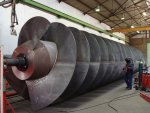Ian_Edwards
Well-known member
How do you repair screw holes, where the self tappers have been taken in and out too many times, so that the holes in the timber are oversized and the slf tappers no longer grip properly. This has happened on the self tappers that hold some of the floor board down on Eynhallow.
I could use a bit of PVA adhesive and some scraps of wood pushed into the holes, but is there a better method which would give a more permanent fix?
I could use a bit of PVA adhesive and some scraps of wood pushed into the holes, but is there a better method which would give a more permanent fix?

